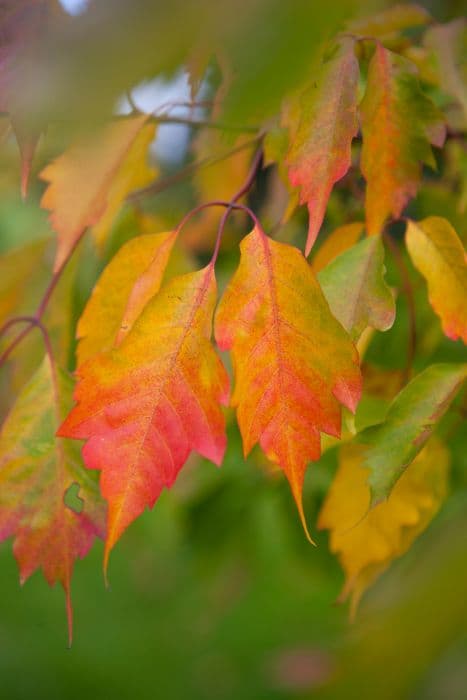Japanese Maple Acer palmatum Metamorphosa = 'Arjos1' (PBR)
![Japanese maple [Metamorphosa]](/_next/image?url=https%3A%2F%2Fplants-admin.emdemapps.com%2Fimages%2Fplants%2F%2Fimages%2F604b566bddf96.png&w=3840&q=75)
ABOUT
Acer palmatum Metamorphosa, commonly referred to as the Japanese Maple 'Metamorphosa,' is a striking ornamental tree known for its distinctive foliage that transforms throughout the seasons, giving it the name 'Metamorphosa.' The leaves of this captivating variety emerge with a pinkish-red hue in spring, with the tips of the lobes typically maintaining a deep purple or reddish tone. As the tree transitions into summer, its leaves evolve into a blend of green and cream, often suffused with pink. This mottling of colors gives the foliage a nearly iridescent appearance in the sunlight. Each individual leaf consists of multiple lobes radiating from a central point, resembling an open hand with outstretched fingers – hence its specific name, which refers to the palmate nature of the leaves. The texture of the leaves is smooth, and their edges may exhibit slight serration or subtle rippling. Once autumn arrives, the Japanese Maple 'Metamorphosa' steals the spotlight yet again. Its leaves take on a fiery array of colors. Shades of orange, red, and yellow showcase a vivid display that is typical of many Japanese Maples, making it a focal point in any garden setting. Aside from its enchanting foliage, the Japanese Maple 'Metamorphosa' also possesses an appealing branching structure that adds an architectural element to the landscape. Its branches may grow in a somewhat upright, yet graceful manner. The bark of the tree itself is typically smooth with a greyish hue, providing a pleasant contrast to the dramatic foliage it supports. Overall, the ever-changing beauty of the Japanese Maple 'Metamorphosa' makes it a dynamic and attractive addition to suitable garden spaces, drawing the eye with its seasonally evolving palette and elegant form.
About this plant
 Names
NamesFamily
Sapindaceae
Synonyms
Japanese Maple
Common names
Acer palmatum Metamorphosa = 'Arjos1' (PBR).
 Toxicity
ToxicityTo humans
The Japanese Maple is generally not considered toxic to humans. Ingesting parts of this plant typically does not lead to any severe symptoms of poisoning. However, as with any plant material, individual allergies and reactions can occur, and it is generally advisable to avoid ingesting plant parts that are not commonly used as food.
To pets
The Japanese Maple is not known to be toxic to pets. It is not associated with causing serious symptoms of poisoning if pets ingest parts of the plant. Nevertheless, pet owners should always monitor their pets and prevent them from eating large amounts of any non-food plants, as this can cause digestive upset or other health issues unrelated to toxicity.
 Characteristics
CharacteristicsLife cycle
Perennials
Foliage type
Deciduous
Color of leaves
Varies
Height
6-8 feet (1.8-2.4 meters)
Spread
6-8 feet (1.8-2.4 meters)
Plant type
Shrub
Hardiness zones
5
Native area
Japan
Benefits
 General Benefits
General Benefits- Ornamental Appeal: The Acer palmatum Metamorphosa, commonly known as the Japanese Maple 'Metamorphosa', has a diverse range of leaf colors through the seasons, adding visual interest to gardens.
- Compact Size: It tends to have a smaller, compact size that makes it suitable for smaller gardens or limited spaces.
- Seasonal Interest: With changing leaf colors in spring, summer, and fall, this plant offers year-round aesthetic appeal.
- Shade Tolerance: Japanese Maples can thrive in partially shaded areas, making them versatile for different garden designs.
- Enhances Biodiversity: It can attract birds and other wildlife, promoting a diverse ecosystem within the garden.
- Low Maintenance: This variety, like many Japanese Maples, typically requires minimal pruning and care once established.
- Drought Resistance: Once established, they can be somewhat drought tolerant, reducing the need for frequent watering.
 Medical Properties
Medical PropertiesThis plant is not used for medical purposes.
 Air-purifying Qualities
Air-purifying QualitiesThis plant is not specifically known for air purifying qualities.
 Other Uses
Other Uses- Acer palmatum Metamorphosa can be used in bonsai cultivation due to its attractive foliage and branching structure, allowing enthusiasts to shape and display miniature versions of this tree.
- In photography, the striking color transitions of the leaves provide a picturesque backdrop for portrait and nature photography sessions.
- This plant's leaves can be used in art projects, such as leaf pressing, providing a natural and colorful component to the artwork.
- The wood of Acer palmatum Metamorphosa can be crafted into small woodworking projects, like jewelry boxes or picture frames, showcasing its fine grain when polished.
- Landscape architects may use this plant to create a 'living sculpture' by training and pruning the branches to form artistic shapes in a garden setting.
- The contrasting foliage can be used as a reference or inspiration for designers and artists seeking color palettes for their visual works.
- In culinary presentations, leaves can be utilized as a natural decoration to enhance the visual appeal of gourmet dishes, though they are not edible.
- Foliage color changes can be an educational tool for teaching biology concepts like photosynthesis and pigment change in plants in classrooms or workshops.
- Leaf casting with concrete or plaster can immortalize the unique form of Acer palmatum Metamorphosa leaves for decorative stepping stones or wall art in gardens.
- For collectors of plant memorabilia, the leaves can be included in scrapbooking or herbarium collections, preserving the memory of the plant's beauty.
Interesting Facts
 Feng Shui
Feng ShuiThe Japanese Maple is not used in Feng Shui practice.
 Zodiac Sign Compitability
Zodiac Sign CompitabilityThe Japanese Maple is not used in astrology practice.
 Plant Symbolism
Plant Symbolism- Beauty and Elegance: The Acer palmatum, commonly known as the Japanese Maple, is often associated with beauty and elegance due to its delicate leaves and striking colors, which can range from vibrant greens to deep purples and reds.
- Change and Transformation: The 'Metamorphosa' variety, which hints at the word "metamorphosis," suggests a symbolic meaning of change and transformation, reflecting the tree's changing leaf colors throughout the seasons.
- Peace and Tranquility: Japanese maples are a staple in Asian gardens, particularly in Japan, where they are admired for their calming presence, thus symbolizing peace and tranquility.
- Balanced and Graceful Strength: Although delicate in appearance, Japanese maples are hardy trees, symbolizing a balanced and graceful strength that endures over time.
- Enduring Love and Fidelity: In some cultures, the Japanese Maple is seen as embodying love and fidelity due to its perennial nature and the long lifespan of the tree.
 Water
WaterThe Japanese Maple 'Metamorphosa' should be watered deeply, allowing the soil to become slightly dry between waterings. Generally, young trees require watering once a week, especially during dry spells. For mature trees, a deep watering every two weeks may suffice, providing about 2 to 3 gallons per session, depending on the size and conditions such as soil type and weather. During the summer months, when evaporation rates are high, more frequent watering may be necessary. However, it's crucial to avoid waterlogging the soil as Japanese Maples are sensitive to overwatering.
 Light
LightJapanese Maple 'Metamorphosa' thrives in partial shade to filtered sunlight. It is best positioned where it receives morning sun and afternoon shade, as intense afternoon sun can scorch the delicate leaves. A spot with dappled sunlight under the high canopy of larger trees or on the east or north side of a building is ideal for protecting the foliage from harsh rays.
 Temperature
TemperatureJapanese Maple 'Metamorphosa' prefers moderate temperatures and can be sensitive to extreme heat or cold. It can withstand a minimum temperature of around 20°F before sustaining damage. Optimal growth occurs in temperatures ranging from 60°F to 75°F. During winter, some protection may be required if temperatures frequently drop below this range.
 Pruning
PruningPrune the Japanese Maple 'Metamorphosa' to maintain its shape and health. The best time for pruning is late winter to early spring before new growth starts. Light pruning can be done to remove dead or crossing branches and to shape the tree, but heavy pruning should be avoided to maintain the tree's natural form. Pruning every 2 to 3 years is often sufficient for healthy growth and aesthetic maintenance.
 Cleaning
CleaningAs needed
 Soil
SoilJapanese Maples like the 'Arjos1' thrive in well-draining, sandy loam soil with a pH between 5.5 and 6.5. An ideal soil mix should contain organic matter like compost or well-rotted manure to enhance fertility and aeration.
 Repotting
RepottingJapanese Maples should be repotted every 2-3 years in spring. Repotting ensures that the 'Arjos1' has adequate room for root growth and access to fresh nutrients.
 Humidity & Misting
Humidity & MistingJapanese Maples prefer moderate humidity levels. The 'Arjos1' does well in natural outdoor humidity, but avoid excessively dry or damp conditions.
 Suitable locations
Suitable locationsIndoor
Provide bright light, avoid dry heat, and maintain soil moisture.
Outdoor
Plant in partial shade, protect from harsh sun and winds.
Hardiness zone
5-9 USDA
 Life cycle
Life cycleThe Japanese maple 'Metamorphosa', also known as Acer palmatum 'Arjos1' (PBR), begins its life cycle as a seed, which after stratification germinates in the spring when temperatures rise. The seedling stage follows, where the plant develops its first true leaves and starts photosynthesizing, gradually forming a juvenile plant with a basic root system and stem structure. As it enters the vegetative stage, it experiences rapid growth, producing more complex leaf patterns and branching, characteristic of the cultivar. The transition to maturity involves the development of the distinctive foliage color changes for which 'Metamorphosa' is named, and the tree's woody structure becomes more pronounced. Mature trees will periodically flower, leading to the production of samaras, or winged seed pods, which, upon dispersal, can initiate new life cycles if conditions are favorable. Throughout its life, the Japanese maple will undergo several seasonal changes with leaves evolving in hues, and eventually reach senescence, where growth slows and the plant may die back naturally over the years or due to environmental stress.
 Propogation
PropogationPropogation time
Spring-Early Summer
The most popular method for propagating the Japanese Maple 'Acer palmatum Metamorphosa' is by softwood cuttings. This technique is usually carried out in early summer when new growth is still supple. Gardeners take cuttings of about 4 to 6 inches (10 to 15 centimeters) in length, making sure each piece has at least two or three sets of leaves. The lower leaves are removed, and the cut end is dipped in rooting hormone before being placed in a well-draining potting mix. To maintain high humidity, the pot can be covered with a plastic bag or placed in a greenhouse. Rooting can take several weeks, and once rooted, the new saplings can be gradually acclimatized to outside conditions before being planted out.









